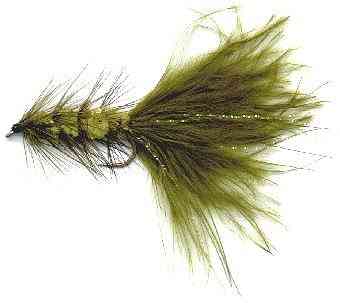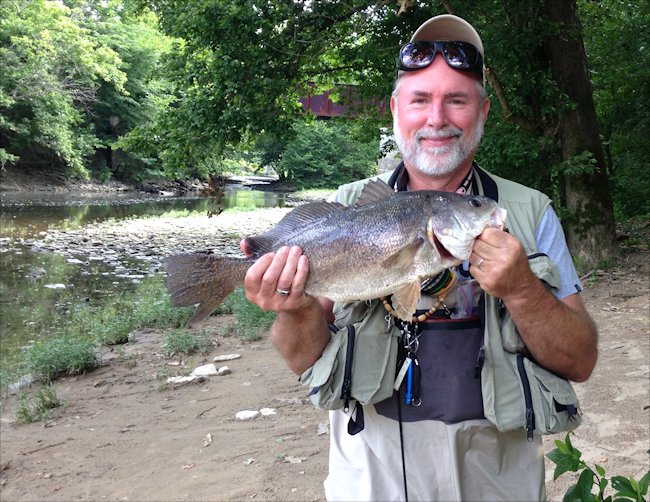The Olive Woolly Bugger Fly
The Woolly Bugger fishing fly pattern has to be one of the most versatile and productive flies around. The marabou tail and in most cases a palmered body suggest succulent small juvenile bait fish, insect larva, tadpoles or leeches that trout, bass and steelhead devour

WOOLLY BUGGER STREAMER FLY PATTERN. Hook size 10 4 2 - $US each
When to strike when fishing a woolly Bugger fly.
Some trout will make big fuss behind your brown Woolly bugger fly pattern. Seldom, though does a trout just engulf your streamer. Rather like a heat seeking missile, a trout locks onto your woolly bugger. He locks on to the target, homes in on the target and then strikes.
This is the frustrating bit. You will sometimes not know when the trout will strike. A follow can just erupt out of the murk. Trout can give chase for a long period of time but some chose to go onto attack mode almost immediately. Some, for reasons best known to themselves, just seem to get bored with the whole idea, and give up the chase.
Those trout that enjoy chasing the woolly bugger streamer for a very long time don’t know it is an artificial fly. The shape of your fly and the movement in the marabou tail has fooled them into thinking it is the real deal and alive. Keep pulling.
You will, frustratingly, get quite a number of follows to actual hook-ups. I fish for takes. It preserves your sanity. The fish, not you, does the striking bit. When the whole leader, line and rod tip feel heavy, strike then.
Whatever you do, do not make a move to strike when you see that first trout swirl. This is fun fishing not hard core competition fish catching. Take a sense of humour with you along to the water. Have fun but stay safe and keep warm.

CUSTOMER'S PHOTO
Caught on your olive woolly buggers on a 4wt outfit in July. I'm holding is a 21" freshwater drum (around 6lbs. or so). Caught at the confluence of the two forks of the Whitewater River in Indiana. The west fork is a larger warm water river and the east is a two mile tail water of cold water from Brookville Lake. So on a given day you can catch browns, rainbows and a dozen different warm water species in the same general area. A rather unique fishery in the middle of the USA to be sure. Thanks, Jeff
LINKEDIN COMMENT
The Woolly Bugger is an awesome pattern and hard to fish wrong. Olive is probably my favorite,But many colors work. I sometimes tie the tail a little longer than some for more of the "wiggle on a slow rise. I have caught some nice spring salmon this way. By Dan Smith
FACEBOOK READER'S COMMENT
I luv the woolly bugger it is the first fly I began with brings memories. Zuze Luwizhi
FACEBOOK READER'S COMMENT
Hard to beat an olive woolly bugger. I tell people learning fly fishing there is no wrong way to fish an olive bugger, that it just catches fish. - Daryn Smith
FACEBOOK READER'S COMMENT
The Woolly Buger is a fairly versatile fly from #2 to #16. The size will dictate how you fish it. Keep it close to the bottom - a bit of non-lead wire helps. On small sized I would use copper wire to add a little weight. Bill Wolford
FACEBOOK READER'S COMMENT
When fishing with a Woolly bugger in moving water make certain to mend upstream couple times to let fly sink and then let fly sit at end of swing; do not strip immediately but wait a couple seconds, maybe give a little jiggle. For stillwater, vary depths and rate/length of strips.- Chris Simmonds.
FACEBOOK READER'S COMMENT
When fishing with a Woolly bugger Cast 90°, or 45° upstream, towards/away from bank, rocks, debris; with a mend or two; stripping, varying on daily conditions. Water depth will dictate leader weight. Scott Russell
FACEBOOK READER'S COMMENT
When using a wolly bugger I cast high enough in front of fish to get it to the natural depth. (in current). Keep as less as possible line on water (to keep fly in strike zone) and hold on. Duane Doroba


Fly Fishing books

